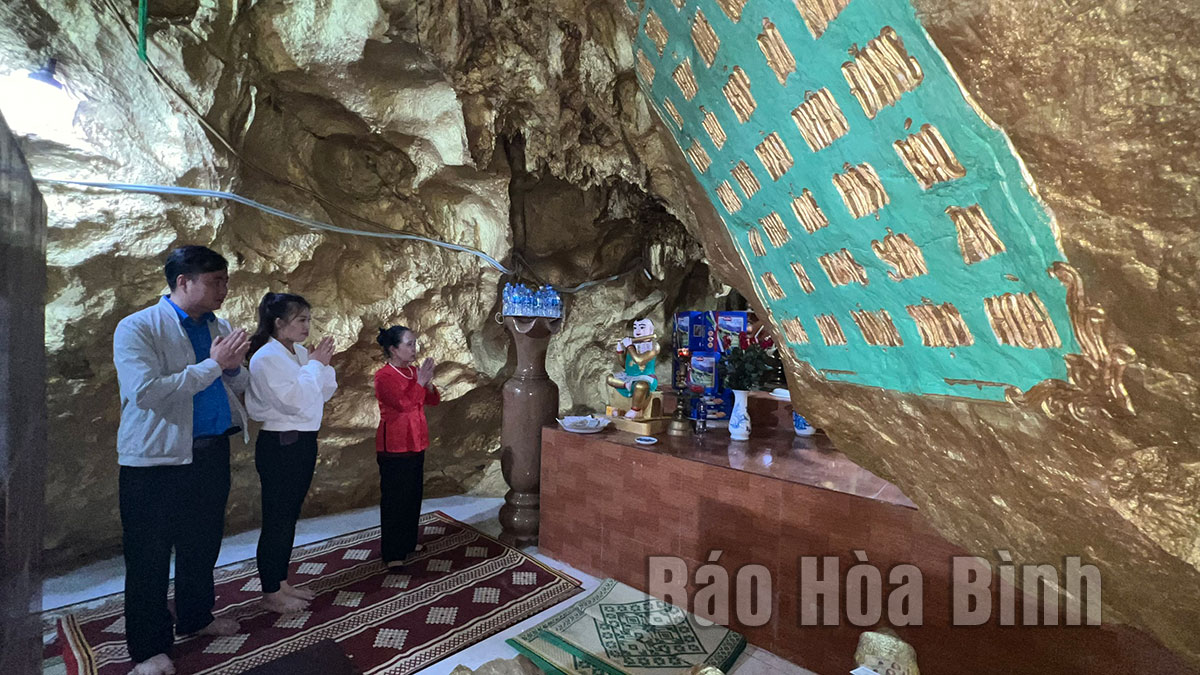



The tourists are visiting and worshiping at Niem mountain relics in Chua village, Phu Thanh commune (Lac Thuy).
It is about 3 km from the center of Phu Thanh commune, the coplex of Niem mountain relics is located in Ba Co mountain range, including 3 adjacent relics: the cultural historical relic of Niem temple, the scenic relic of Thong Linh cave, relic archeology of Niem rock roof. Niem temple has been existed for a long time, originally a small temple at the foot of the mountain, worshiping the three Muong gods. Ỉ has been said that the local people in the area saw the halos on the mountain range land and then they disappeared. It is said to be the embodiment of the three Muong lords who came to help establish the people and establish a hamlet. To commemorate the merits, the people built a temple at the foot of the mountain. Whenever there is a big event in the village, the officials and the local people come to the temple to pray for blessings, the name Niem mountain is called from there.
Ms. Bui Thi Lan from Chua village has been entrusted to manage the entire area of tthe complex of Niem mountain. Ms. Lan says: "My family has been making incense sticks for 4 generations at Niem temple, taking over the management and organizing the rituals in the temple. Every year, the temple welcomes thousands turns of visitors, especially during holidays and Tet. All the revenue and expenditure activities in the temple are self-governing, the annual revenue is from the merits and the service is counted and deducted to repair and renovate the relics. It is hoped to get support from the commune to repair and widen the roads to the the relics of Niem mountain, and to plan a spacious parking for tourists.
We continued visiting the monument with the guidance of Mrs. Lan to Thong Linh cave. Previously, the cave was invaded and filled by alluvium from Boi River. In 2009, the government and the local people dredged and digged to restore the temple, which revealed a cave with countless beautiful stalactites and stalagmites. Thong Linh cave is divided into 2 arches. The first arch is 10 m wide on average, the deepest is 15m, the highest is 17m with a monolithic rock blocking the path, forming 2 main niches into the cave. The first niche is 2.5m wide on average and 12m deep and it is the world of shimmering and fanciful stalactites. The block from above radiates down like a giant flower, the block is like a fairy's skirt fluttering in the wind, the block rises like a tree against the sky or an ancient banyan tree. Coming to the second arch with a length of over 20m, the widest place is 6m, the ceiling arch is from 2-14m high, we can admire the world of stalactites, however, it is a rich countryside scene like carved from the outside. The stalactites grow staggered from the cave floor rising up like a garden full of fruits interspersed with houses.
Leaving the small alley and going to the southwest of the cave entrance, following a winding staircase leading out of the cave entrance, the cave entrance is about 15 m higher than the field. The blowing wind from the field carries the fragrance of fruits as if it awakens the people to reality of exploring the Niem stone roof. In September 2012, the Provincial Museum collaborated with the Center of the Southeast Asian Prehistoric Research to survey the caves in Ba Co range and Niem mountain. Through the survey, the delegation obtained over 300 tools of all kinds: Hoa Binh culture stone, bone, mollusk... These are the important documents for the process of studying Hoa Binh culture. In addition, other highlights of the relic site such as the bas-relief "Cuu Long Tranh Chau”, the ancient gongs, the bronze drums, etc., especially the festival of the communal house in Chua village, held on January 5 every year, attracts the attention of large number of tourists from all over the country.
Mr. Bui Thi Hoa, the Vice Chairman of Phu Thanh Commune’s People's Committee says: The complex of Niem mountain relic is meaningful in terms of history, culture, spirituality with bold national identity. Along with other relics and scenic spots of the district such as Tien pagoda, money printing factory, the relic complex of Niem mountain has been contributing to adorn the tourism picture of Lac Thuy district, promoting to tourists near and far, generating the revenue from service for the locality.